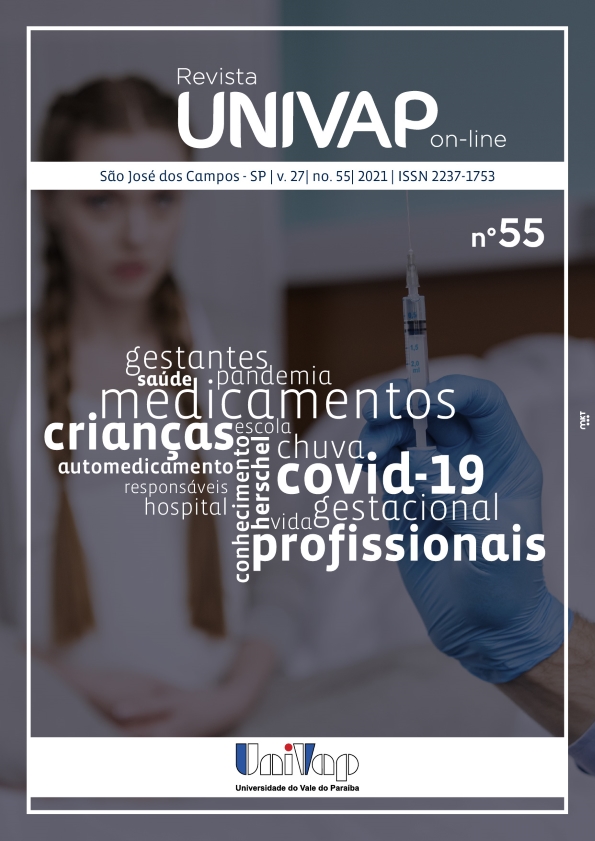EFEITOS DA TERAPIA VIRTUAL NA FUNÇÃO MOTORA DO MEMBRO SUPERIOR PARÉTICO DE PACIENTES PÓS ACIDENTE VASCULAR ENCEFÁLICO
DOI:
https://doi.org/10.18066/revistaunivap.v27i55.2531Keywords:
Acidente vascular encefálico, aprendizado motor, neuroplasticidade, terapia virtual.Abstract
Este artigo teve como objetivo avaliar os efeitos da Terapia Virtual (TV) no membro superior parético de indivíduos pós AVE. Participaram do estudo seis voluntários, que realizaram a terapia virtual utilizando o vídeo game XBOX 360, por meio do jogo vazamentos. Foram realizados 10 atendimentos de tratamento ininterruptos, por 30 minutos, durante duas semanas. A avaliação consistiu na quantificação da força e atividade mioelétrica no primeiro, no sexto e após o décimo atendimento. Os resultados mostraram aumento significativo da força, com consequente aumento da atividade elétrica do músculo bíceps braquial e diminuição da atividade mioelétrica para o músculo tríceps braquial (p<0,05). Desse modo, acredita-se que esta forma de terapia possa ser associada aos recursos terapêuticos convencionais para acelerar o processo de reabilitação de indivíduos hemiparéticos espásticos.Downloads
References
ARAMAKI, A. L. et al. Realidade virtual na reabilitação de pacientes após acidente vascular cerebral: uma revisão integrativa. Arquivos de Neuro-Psiquiatria, v. 77, n.4, p. 268-278, 2019. Doi: 10.1590/0004-282X20190025.
CARLYLE, J. K.; MOCHIZUKI, G. Influence of post-stroke spasticity on EMG-force coupling and force steadiness in biceps brachii. Journal of Electromyography and Kinesiology, v. 38, p. 48-55, 2018. Doi: 10.1016/j.jelekin.2017.11.005.
CARVALHO, R. et al. Physiotherapy based on problem-solving in upper limb function and neuroplasticity in chronic stroke patients: A case series. Journal of Evaluation in Clinical Practice, v. 24, n. 3, p. 552-560, 2018. Doi: 10.1111/jep.12921.
CHANG, S. H. et al. Spasticity, weakness, force variability, and sustained spontaneous motor unit discharges of resting spastic paretic biceps brachii muscles in chronic stroke. Muscle Nerve, v.48, n. 1, p. 85–92, 2013. Doi: 10.1002/mus.23699.
CHOI, Y. H.; PAIK, N. J. Mobile Game-based Virtual Reality Program for Upper Extremity Stroke Rehabilitation. Journal of Visualized Experiments, n. 133, p. 56241, 2018. Doi: 10.3791/56241.
DIAS, M. P. F. Efeito imediato da realidade virtual sobre a atividade eletroencefalográfica e eletromiográfica no membro superior parético após acidente vascular encefálico. 2018. 98 f. Dissertação (Mestrado em Ciências da Reabilitação) – Universidade Federal de Alfenas, Alfenas, 2018.
IKBALI AFSAR, S. et al. Virtual Reality in Upper Extremity Rehabilitation of Stroke Patients: A Randomized Controlled Trial. Journal of Stroke and Cerebrovascular Diseases, v.27, n.12, p.3473-3478, 2018. Doi: 10.1016/j.jstrokecerebrovasdis.2018.08.007.
KHAN, F. et al. Neurorehabilitation: applied neuroplasticity. Journal of Neurology, v. 264, n. 3, p. 603-615, 2016. Doi: 10.1007/s00415-016-8307-9.
KIPER, P. et al. Virtual Reality for Upper Limb Rehabilitation in Subacute and Chronic Stroke: A Randomized Controlled Trial. Archives of Physical Medicine and Rehabilitation, v. 99, n. 5, p. 834-842, 2018. Doi: 10.1016/j.apmr.2018.01.023.
LAUDY-EKMAN, L. Neurociências: fundamentos para reabilitação. 3ed. Rio de Janeiro: Elsevier, 2008.
LEE, G. Effects of Training Using Video Games on the Muscle Strength, Muscle Tone and Activities of Daily Living of Chronic Stroke Patients. Journal of Physical Therapy Science, v. 25, n. 5, p. 595-597, 2013. Doi: 10.1589/jpts.25.59.
LODHA, N. et al. Force control and degree of motor impairments in chronic stroke. Clinical Neurophysiology, v. 121, n. 11, p. 1952-1961, 2010. Doi: 10.1016/j.clinph.2010.04.005.
MAGGIO, M. G. et al. Virtual Reality and Cognitive Rehabilitation in People With Stroke. Journal of Neuroscience, v. 51, n. 2, p. 101-105, 2019. Doi: 10.1097/JNN.0000000000000423.
NAM, K. E. et al. When does spasticity in the upper limb develop after a first stroke? A nationwide observational study on 861 stroke patients. Journal of Clinical Neuroscience, v. 66, p. 144-148, 2019. Doi: 10.1016/j.jocn.2019.04.034.
PUNDIK, S. et al. Association of spasticity and motor dysfunction in chronic stroke. Annals of Physical and Rehabilitation Medicine, v.62, n.6, p.397-402, 2018. Doi: 10.1016/j.rehab.2018.07.006.
SCHUSTER-AMFT, C. et al. Effect of a four-week virtual reality-based training versus conventional therapy on upper limb motor function after stroke: A multicenter parallel group randomized trial. PLOS ONE, v. 13, n. 10, p. e0204455, 2018. Doi: 10.1371/journal.pone.0204455.
TANAKA, H. et al. Spatiotemporal gait characteristic changes with gait training using the hybrid assistive limb for chronic stroke patients. Gait and Posture, v. 71, p. 205-210, 2019. Doi: 10.1016/j.gaitpost.2019.05.003.
TRICCAS, L. T. et al. Predictors of upper limb spasticity after stroke? A systematic review and meta-analysis. Physiotherapy, v.105, n.2, p.163-173, 2019. Doi: 10.1016/j.physio.2019.01.004.
Downloads
Published
How to Cite
Issue
Section
License

This work is licensed under a Creative Commons Attribution 4.0 International.
This license allows others to distribute, remix, tweak, and build upon your work, even commercially, as long as they credit you for the original creation.
http://creativecommons.org/licenses/by/4.0/legalcode


